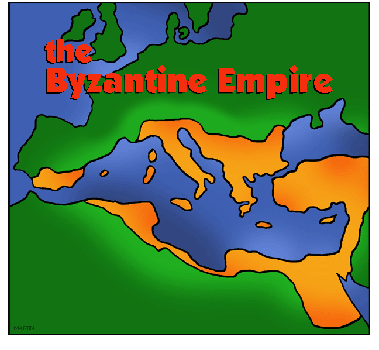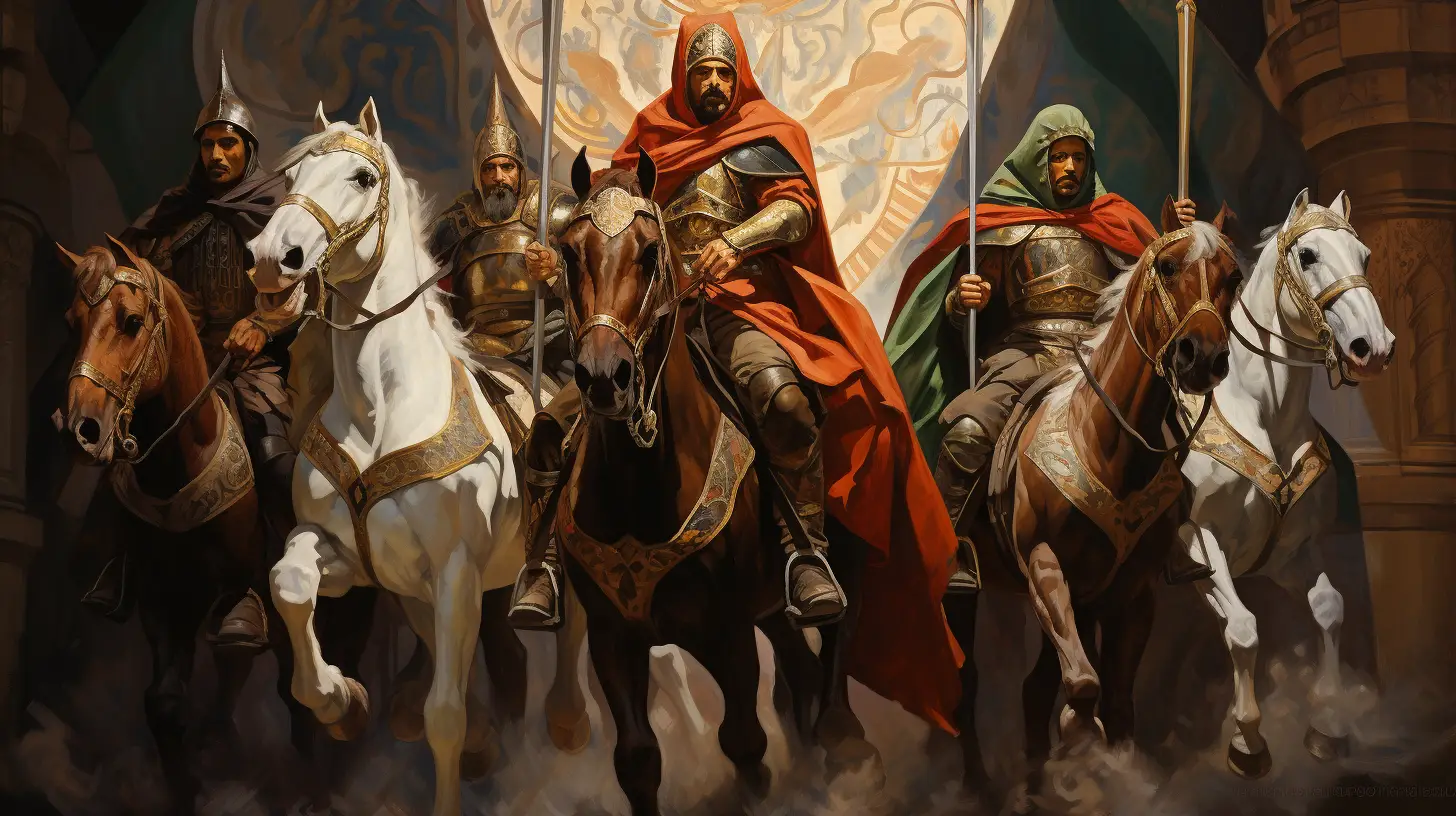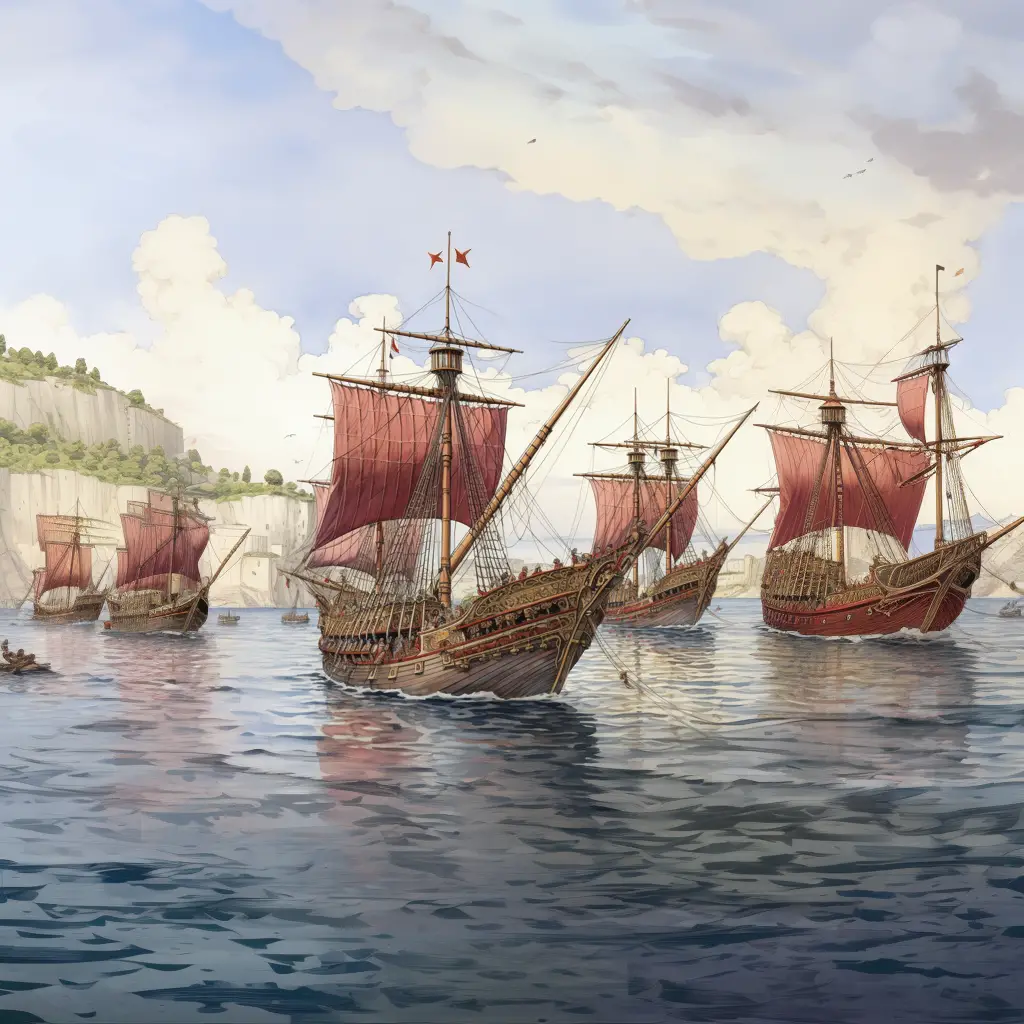The Byzantine Empire
By the 300s, the Roman Empire could no longer control its long borders and far-flung outposts. After Constantine I took over, he divided the Roman Empire into east and west. The eastern half became the Byzantine Empire, which endured for 1000 years. It was the only “organized state” west of China to survive without interruption from ancient times until the beginning of the modern era.

Byzantine Empire Facts For Kids
- The Byzantine Empire lasted from 330 to 1453 AD.
- It was also known as the Eastern Roman Empire.
- Its capital was Constantinople, now Istanbul.
- Its official language was Greek, not Latin.
- Emperor Justinian I built the Hagia Sophia.
- They created their own law code, the “Justinian Code”.
- Their currency was the gold Byzant, a coin.
- The Empire was known for its mosaics and icons.
- They used Greek Fire, an early flamethrower.
- It fell to the Ottoman Turks in 1453.
Justinian I
Known as Justinian the Great, Justinian I was a significant Byzantine Empire ruler who held reign from 527 to 565 AD, marking the pinnacle of the empire’s cultural and political influence. His most noteworthy achievement was the ‘Corpus Juris Civilis,’ a comprehensive codification of Roman law that served as the foundation for Byzantine legal practices and significantly influenced legal development in the Middle East and Europe.
Justinian I also initiated significant architectural projects, including the Hagia Sophia, a symbol of Byzantine architectural accomplishment still standing in present-day Istanbul.
His tenure was characterized by efforts to reclaim lost territories and restore the Roman Empire to its former grandeur, successfully recapturing parts of the Western Roman Empire, such as Italy and North Africa.
Fall of Constantinople
Marking a pivotal point in world history, the fall of Constantinople in 1453 signified the end of the Byzantine Empire, a beacon of Greek culture and Orthodox Christianity, endured for over a thousand years.
The empire’s capital, Constantinople, was a renowned hub of commerce, culture, and architectural marvels such as the Hagia Sophia. However, a series of invasions and internal conflicts gradually eroded its territories.
The empire met its end when Mehmed the Conqueror led the Ottoman Turks in a siege of Constantinople, and despite fierce resistance, the city succumbed. This moment not only marked the end of the Byzantine Empire but also the inception of the Ottoman Empire, profoundly impacting the geopolitical landscape of Europe and the Middle East.
Byzantine Art and Architecture
The Byzantine Empire profoundly influenced the evolution of art and architecture, creating some of the world’s most renowned works. Known for its unique style, Byzantine art is characterized by religious symbolism, rich detailing, and vibrant use of color, with gold leaf often being a prominent feature. Iconography played a significant role in Byzantine art, with the depiction of holy figures aiming to inspire devotion and communicate spiritual truths.
Equally impressive is Byzantine architecture, epitomized by the Hagia Sophia in Istanbul, a testament to the empire’s opulence and innovative engineering. It’s massive domes and intricate mosaics showcase Byzantine architects’ pioneering work, particularly in the development of the pendentive dome construction, which facilitated the positioning of a circular dome over a square room.
Despite the fall of the Byzantine Empire, its profound influence on art and architecture continues to resonate across various cultures and eras.
Eastern Orthodox Church
The Byzantine Empire, also known as the Eastern Roman Empire, was profoundly connected to the Eastern Orthodox Church, which fundamentally influenced its culture, politics, and society, to the extent that it was recognized as the state religion.
The Emperor was regarded as the divine representative on earth, while the Patriarch of Constantinople occupied the second highest position in the church hierarchy, just underneath the Emperor. This intimate association between the church and state in the Byzantine Empire was termed caesaropapism.
The Church’s significant influence extended to Byzantine art, architecture, and education, permeating many of the empire’s most renowned mosaics and structures, including the Hagia Sophia, with Christian symbolism.
The Eastern Orthodox Church also played a pivotal role in safeguarding Greek and Roman cultural heritage during the Middle Ages, positioning the Byzantine Empire as a vital link between antiquity and the Renaissance.
Iconoclasm

In the 8th and 9th centuries, the Byzantine Empire experienced Iconoclasm, a significant religious shift that advocated for the destruction of religious images or icons based on the belief that their worship was akin to idolatry, a violation of the Ten Commandments.
This movement, officially endorsed by Byzantine Emperors Leo III and Constantine V, led to the widespread destruction of religious artifacts throughout the empire. However, the period concluded with the reign of Empress Theodora, who restored the veneration of icons.
The Iconoclast controversy had profound effects on Byzantine society, not only influencing religious and political life but also widening the divide between the Eastern and Western Churches and leaving a lasting impact on the aesthetic evolution of Byzantine art.
Theodora, wife of Justinian I
Theodora recognized as a significant figure in Byzantine history, rose from a humble background to become the influential wife of Emperor Justinian I. Her profound impact on Justinian shaped the political landscapes of the Byzantine Empire.
Notably, she championed women’s rights, spearheading reforms in divorce and property laws that greatly enhanced women’s societal status. During the Nika riots of 532 AD, Theodora exhibited remarkable bravery and resolve, persuading Justinian against abandoning Constantinople, a decision that ultimately preserved his reign.
Despite the prevalent patriarchal norms, Theodora achieved recognition as a co-ruler, an unprecedented status underscored by her image on coins and mosaics alongside Justinian. This solidifies her place as one of the most powerful women in Byzantine history.
Byzantine Economy
One of the most enduring and robust features of the Byzantine Empire was its economy, which, in its complexity and dynamism, could be likened to modern economies. The Byzantine economic model was a mixture of farming and trading, both of which were vital to its strength and resilience.
Agricultural abundance, particularly from Asia Minor and the Balkan regions, yielded food surpluses that sustained the populous urban centers, especially Constantinople. The strategic geographical position of the empire, between Europe and Asia, bolstered by its advanced infrastructure of roads and sea routes, made trade a significant component of the economy.
Byzantine merchants engaged in far-reaching trade networks, dealing in commodities such as silk, spices, precious metals, and wine with distant lands like China, India, and Scandinavia. The Byzantine economy was further supported by a sophisticated tax system and a strong, stable currency, the gold solidus, which was widely accepted over centuries.
Despite facing numerous challenges, such as wars and territorial loss, the resiliency of the Byzantine economy played a key role in the empire’s longevity.
Byzantine-Sassanid Wars
The Byzantine-Sassanid Wars, a series of conflicts that spanned over 400 years, were fought between the Eastern Roman Empire, later known as the Byzantine Empire and the Sassanid Empire of Persia. The character of both empires was profoundly shaped by these wars, which had a significant influence on world history.
Characterized by shifting alliances, vast battlefield strategies, and political machinations, the wars saw the Byzantine Empire maintain its territorial integrity, despite often being outnumbered and outmatched. However, the continual diversion of resources for the war effort greatly strained the Byzantine economy, resulting in the devaluation of its currency.
A notable consequence of these wars was the exhaustion of both empires, which left them susceptible to the rapid emergence and expansion of the Islamic Caliphate in the mid-7th century.
Byzantine Military

Recognized as the Eastern Roman Empire, the Byzantine Empire boasted a formidable and globally dominant military during its zenith. Its military structure was underpinned by high levels of organization, discipline, and innovative strategic approaches.
A unique facet of their military arsenal was the Greek Fire, an enigmatic incendiary weapon that retained its burning capability even on water, proving vital during naval confrontations. Further testament to their military ingenuity was their defensive tactics, notably the erecting of the three-layered walls of Constantinople, which remained virtually unbreachable for over a thousand years.
These elements collectively underscored the Byzantine Military’s pivotal role in the empire’s endurance for over a millennium, demonstrating its adaptability in the face of evolving circumstances and threats.
Byzantine Civil Service
The Byzantine Empire, known for its highly effective and advanced civil service, was built on a meticulous hierarchy of offices and ranks filled through an extensive selection process, which often involved examinations.
The civil service carried out various functions, including tax collection, law enforcement, and judicial administration. Furthermore, it was integral in the upkeep of public infrastructure, such as roads and aqueducts. The civil service also significantly contributed to the compilation and preservation of legal codes, thereby establishing the rule of law throughout the empire.
The efficiency and professionalism of the Byzantine civil service were key to the empire’s longevity and stability and set a standard for future administrative systems in Europe and beyond.
Byzantine Intellectuals
The Byzantine Empire was a beacon of intellectual pursuit and preservation during the Middle Ages. Renowned for their scholarly endeavors, Byzantine intellectuals preserved classical texts, created influential commentaries, and produced their own distinctive works in areas like theology, philosophy, history, and law. They also translated Greek knowledge into Arabic, playing a pivotal role in the survival of ancient wisdom. Their vast efforts helped lay the intellectual groundwork for the Renaissance in Western Europe, making Byzantine intellectuals central to the course of intellectual history.
Catholic Church
The Byzantine Empire played a significant role in the shaping of Christianity. It was the heartland of the Eastern Orthodox Church, which split from the Roman Catholic Church in 1054, in what’s known as the Great Schism. Differences in theology, language, and ecclesiastical politics led to this division. However, the Byzantine Empire also played a role in the spread of Christianity, as its missionaries evangelized Eastern Europe. Despite the schism, both Churches share many traditions dating back to this common Byzantine heritage.
Ottoman Sultan Mehmed II
Sultan Mehmed II, also known as Mehmed the Conqueror, was the Ottoman ruler who brought the Byzantine Empire to an end. In 1453, he laid siege to Constantinople, the Byzantine capital. Despite the city’s formidable defenses and strategic location, Mehmed’s forces captured it after a hard-fought two-month siege. This marked the end of the Byzantine Empire and the start of Constantinople as an important city in the Ottoman Empire, subsequently renamed Istanbul. Mehmed’s victory signified a new era of Ottoman dominance.
Byzantine Ships

The Byzantine navy was renowned for its powerful warships and use of Greek Fire, a unique incendiary weapon. However, as the Ottoman Empire expanded, it built a formidable fleet to challenge Byzantine dominance in the Aegean and Mediterranean seas. The pivotal moment came during the 1453 Siege of Constantinople when Ottoman Sultan Mehmed II bypassed the Byzantine sea-chain defense by transporting his ships overland using log rollers. This ingenious move helped to breach Constantinople’s defenses and led to the fall of the Byzantine Empire.
Military Hardware
The impressive bronze cannon that graces the courtyard of Fort Nelson Museum is a testament to the technological advancements of the Ottoman Empire under Sultan Mehmed II, who sought to outshine the weaponry of the Byzantine Empire. Commissioned in 1464, this split cannon was a unique innovation in the world of artillery, with its two pieces designed to be assembled in situ following transportation. This gun played a significant role in asserting the military superiority of the Ottomans over the Byzantines. The cannon’s journey to London was a result of Queen Victoria’s appeal to Sultan Abdulaziz, who sent the formidable weapon as a gift in the 19th century, underlining the historical interactions between the East and the West.
Greek Fire
The Byzantine Empire, known for its many technological advances, is perhaps most renowned for its invention of Greek fire. Developed in the 7th century during the reign of Emperor Constantine IV Pogonatus, Greek fire was a weapon of war, a terrifying incendiary substance that continued to burn even on water. Its usage, primarily at sea, provided the Byzantines with a formidable edge in naval warfare, helping them repel Arab sieges, notably the Second Arab Siege of Constantinople in 717–718, thereby preserving the empire’s integrity during precarious times.
Early History
Looking for a place to build a “new Rome” in the East, Constantine I decided in 330 on an ancient Greek site known as Byzantium. A small Greek town had long been thriving there. This “new Rome” became Constantinople (now Istanbul), the center of the Byzantine Empire.
Citizens of the Byzantine Empire saw themselves as both Romans and Christians. The official language was Latin, but many spoke Greek.
As the Western Roman Empire fell apart through internal conflict and constant invasions, the Byzantine Empire expanded and flourished. Byzantine had many geographic advantages, including a shorter frontier with Europe. Constantinople also had a strategic location on the Strait of Bosphorus. The narrow passage connected the Aegean Sea to the Black Sea and separated the continents of Europe and Asia. This location made Constantinople easy to defend and an excellent center for trade between East and west.
The Byzantine Empire built on its geographic advantages to create strong leadership, internal stability, and great wealth. Ruled by Roman law, it became a rich center of art, literature, and learning.
Justinian I
One of the best-known rulers of the Byzantine Empire was Justinian I. He came to power in 527 and ruled until his death in 565. He expanded the empire to include most of the area surrounding the Mediterranean Sea. He oversaw the construction of a beautiful domed cathedral, the Hagia Sophia (“Church of the Divine Wisdom”). Justinian also reformed Roman Law in ways that would later influence modern European and international law.
After Justinian
Justinian had to borrow great sums of money to carry out his wars. He left behind a lot of debt after his death. Rulers who followed him had to tax citizens heavily to maintain the empire. And the imperial army found it hard to hold on to the territory Justinian conquered.
Persians and Slavs threatened Byzantine borders on the East and the North. To the South, armies expanding in the name of the new religion of Islam took over Syria and further eroded Byzantine borders.
Religion, Art, and Architecture in the Byzantine Empire
Christianity took a particular form in the Byzantine Empire: the Eastern Orthodox Church. Missionaries won converts among Slavic peoples. The church inspired a large body of art, such as illuminated manuscripts and icons, that would go on to influence art in Western Europe.
The Golden Age

In the 900s and 1000s, the Byzantine entered a period of relative calm and prosperity, considered its “golden age.” The empire had lost some territory. That meant rulers could focus more on expanding trade and wealth. The government became a patron of arts, restored churches and palaces and promoted the study of Greek history and language.
Rulers of the Byzantine Empire became especially skilled at diplomacy and made many treaties with neighbors to protect peace and trade. The Byzantine economy was the most advanced for its time in Europe. As the western endpoint of the Silk Road, Constantinople welcomed merchants who brought silks, spices, and jewels from Persia, India, and China.
The Fall of the Byzantine Empire
The Byzantine Empire acted as a buffer between Europe and Asia. But as European crusaders passed through Constantinople on their way to battle Muslims in the Holy Land, tensions grew between eastern and Western Christians. Crusaders sacked Constantinople in 1204. After that, a number of Byzantine territories fell under Crusader control or became independent states. The weakened Byzantine Empire finally fell to Ottoman rule in 1453.
Legacy
- As parts of Western Europe fell into chaos, the Byzantine Empire helped to preserve elements of Greek and Roman culture, including many classical manuscripts. These passed back into Europe during the Renaissance.
- Byzantine architecture, such as the Hagia Sophia, influenced later building in Egypt, Arabia, Russia, and Romania.
- Byzantine painting influenced Italian Renaissance artists.
- The modern-day Eastern orthodox church, established in the Byzantine Empire, has become the second-largest Christian church in the world.



